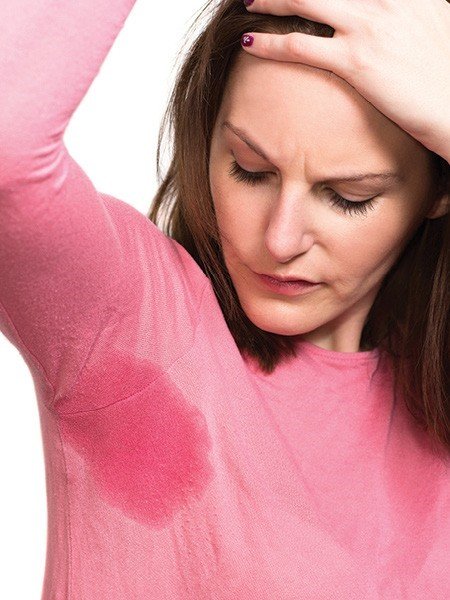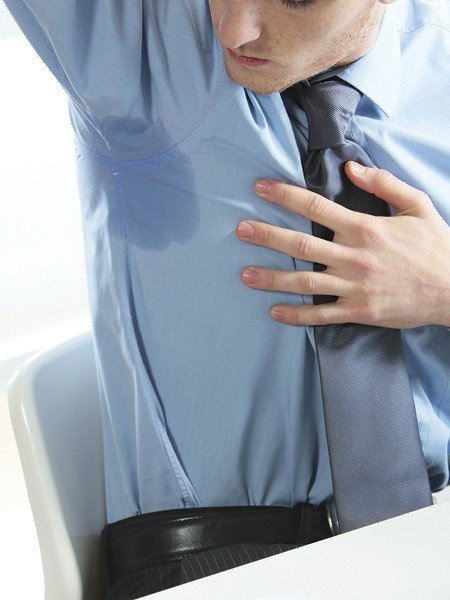Hyperhidrosis is excess sweating. We all need to sweat to keep our bodies cool. However, people with hyperhidrosis seem to have overactive sweat glands. They may sweat even when their body does not need cooling.
Many people who have hyperhidrosis sweat from one or more areas of the body. Most often, they sweat from their palms, feet, underarms, or head. While the rest of the body remains dry, one or two areas may drip with sweat.

Excessive sweating
This excessive sweating can interfere with everyday activities. Hands can be so sweaty that it becomes difficult to turn a doorknob or use a computer. Sweat from the underarms often soaks through clothes, causing obvious sweat marks. Because the skin is often wet, skin infections can develop. It can also interfere with routine social activities such as shaking hands, raising your arm, or hugging someone.
WHAT CAUSES HYPERHIDROSIS?
Certain nerves tell the body when to sweat. It is possible that these nerves overreact, causing excessive sweating.
WHAT ARE THE DIFFERENT TYPES OF HYPERHIDROSIS?
There are two types of hyperhidrosis: primary focal and secondary generalized.
Primary focal hyperhidrosis
- Most often affects the feet, hands, underarms, head, and face
- Affects both sides of the body
- Begins in childhood and it affects the hands and feet. During puberty it can affect the underarms
- Possibly, people inherit the genes that cause this type of hyperhidrosis
Secondary generalized hyperhidrosis
- Results as a side effect from taking a certain medicine or from a medical problem
- Conditions that can cause this type of hyperhidrosis include menopause, an overactive thyroid, diabetic nerve disease (peripheral neuropathy), obesity, and stroke
- Medications, such as blood pressure pills or antidepressants, also can cause this type of sweating. Other causes are exercise and
- Sweating involves large areas of the body
- Can start at any age
- May occur during sleep
WHAT TRIGGERS HYPERHIDROSIS?
Certain situations can trigger your excess sweating. Alternately, nothing might trigger your excess sweating. Keep a journal of the times when you start sweating so you and your dermatologist might be able to determine the situations or triggers you should avoid.
Common triggers include heat, feeling anxious, and certain foods. Foods and beverages that are common triggers contain:
- Monosodium glutamate (MSG)
- Caffeine (chocolate, coffee, tea)
- Hot sauce
- Spices such as curry or cumin
- Alcohol
HOW DO DERMATOLOGISTS DIAGNOSE HYPERHIDROSIS?
When preparing to visit your dermatologist, you may want to think of answers to these questions. Knowing the answers to these questions can assist your dermatologist in determining if you have hyperhidrosis:
- Do any of your blood relatives have excessive sweating?
- When did you first notice the excessive sweating?
- Do you avoid certain activities or social situations because of your sweating?
- How often do you notice that you are sweating excessively?
- Does anything seem to trigger your sweating?
HOW IS HYPERHIDROSIS TREATED?
Antiperspirants – Available with and without a prescription, these sprays, gels, roll-ons, and lotions decrease sweating. The most common ingredient is aluminum chloride hexahydrate. Make sure you are using an antiperspirant rather than a deodorant. Antiperspirants can reduce sweating. Deodorants mask or stop body odor, yet still allow you to sweat.
For best results, apply the antiperspirant to the affected area twice daily, morning and evening. Stop using the product if your skin becomes irritated. Applying antiperspirant at night before sleeping is very helpful. The body is less likely to sweat at this time and rinse away the antiperspirant. You can apply antiperspirant to your palms and the soles of your feet at night. Wash off the product on your palms and soles of the feet in the morning.
Iontophoresis – To treat sweaty hands and feet, you immerse your hands or feet in a shallow pan filled with water. A medical device sends a low-voltage current through the water. This process temporarily shuts off the sweat glands.
When used every other day, it takes about six to 10 treatments until sweating decreases. You must repeat treatments to maintain results.
After receiving instruction on proper use of the device, you may self-administer the treatments at home. The machine is available by prescription only.

Excessive sweating
Botulinum toxin type A
Your dermatologist injects a weak version of this treatment into your underarms. The injections temporarily block a chemical in the body that stimulates the sweat glands. Most patients notice results 2 weeks after receiving treatment.
Reduced sweating lasts about 4 to 6 months — and sometimes longer. When the excessive sweating returns, you can be retreated.
The U.S. Food and Drug Administration (FDA) has approved this treatment for the underarms. Findings from some research studies suggest that this treatment may be effective for other areas of the body.
Oral medication
Your dermatologist may prescribe the oral medications glycopyrrolate and propantheline bromide. These medications prevent the stimulation of sweat glands. Medicines called beta-blockers (for instance, propranolol) also may be a treatment option, mainly for stress-induced sweating. Since all medications have possible side effects, you should talk with your dermatologist about the benefits and potential risks.
Surgery
If other treatments fail to bring relief, surgery may be considered. Surgery is permanent and carries risks. A potential side effect of the surgery to control hyperhidrosis is “compensatory sweating.” This is excess sweating in other areas that may be even worse than the initial hyperhidrosis. This side effect occurs in a significant percentage of patients. Therefore, surgery should be an option only for patients who fully understand the risk and in whom other treatments have failed.
The following surgeries can stop excessive sweating:
- Sweat gland removal – Underarm sweat glands can be removed by curettage (scraping), liposuction, laser surgery or surgical excision (cutting). There may be scars or compensatory sweating after
- Sympathectomy – This procedure interrupts the nervous system impulses to the sweat glands. Doctors use it
mainly to treat the palms.
Hand-held medical device that destroys sweat glands
This is a newer treatment approved by the FDA. A medical doctor such as a dermatologist must administer this
treatment.
This device can only treat the underarms because this area of the body has enough underlying fat to protect itself. This device cannot be used to treat the hands and feet because these areas do not have enough fat.
If this is an option, your dermatologist uses a machine that emits electromagnetic energy. This energy destroys the
sweat glands. In one or two office visits, the glands can be destroyed.
This is a newer treatment option. Unlike other treatments, there is not a lot of information about this treatment
for hyperhidrosis. We do not know how long the results last. Long-term side effects are not known.
A board-certified dermatologist is a medical doctor who specializes in diagnosing and treating the medical, surgical, and cosmetic conditions of the skin, hair and nails. To learn more about hyperhidrosis or find a dermatologist in your area, visit aad.org or call toll free (888) 462-DERM (3376).
All content solely developed by the American Academy of Dermatology.
Copyright © by the American Academy of Dermatology and the American Academy of Dermatology Association.
Images used with permission of the American Academy of Dermatology National Library of Dermatologic Teaching Slides
American Academy of Dermatology
P.O. Box 1968, Des Plaines, Illinois 60017
AAD Public Information Center: 888.462.DERM (3376) AAD Member Resource Center: 866.503.SKIN (7546) Outside the United States: 847.240.1280
Web: aad.org
Email: [email protected]
